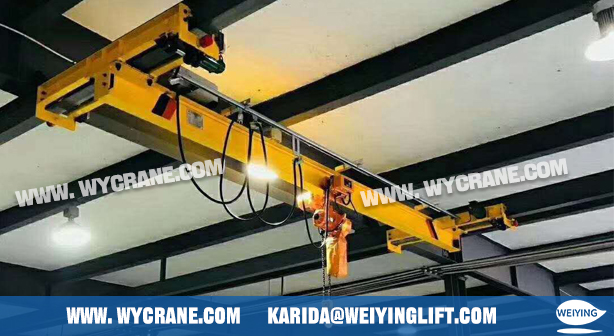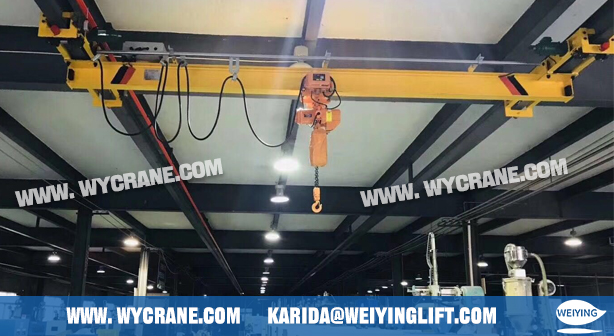Selecting a shop overhead crane is one of the most important decisions for improving workflow efficiency, reducing labor intensity, and ensuring safe material handling inside a workshop. Whether your shop is involved in machining, metal fabrication, equipment repair, small-scale assembly, or parts warehousing, the right overhead crane can significantly increase productivity and provide consistent performance for decades.
Unlike portable lifting equipment or forklifts, a shop overhead crane provides continuous linear movement, stable vertical lifting, and precise load positioning—making it ideal for repetitive or high-accuracy material handling tasks. This article offers a fully detailed guide covering crane types, technical specifications, performance features, application suitability, purchasing considerations, and long-term operation benefits.
 |
 |
A shop overhead crane—also commonly referred to as a shop bridge crane or overhead shop crane—is an overhead lifting system designed to move materials along a fixed runway structure. It consists of several coordinated components:
The main steel beam (single or double girder) that supports the trolley and hoist. Its strength and stiffness determine lifting stability and deflection performance.
Fitted with wheels, motors, and gearboxes, allowing the entire bridge to travel along runway rails with smooth linear motion.
Responsible for vertical lifting and cross-travel movement. Hoists may be wire rope or chain types, with lifting speeds typically ranging from 4–8 m/min, and cross-travel speeds reaching 20 m/min.
Installed on workshop columns or a freestanding support structure. It determines crane span, travel distance, and available lifting height.
Includes power supply lines, control panels, VFD drives, safety switches, and remote-control features for precise operation.
Together, these components enable three-dimensional movement (up, down, left, right, forward, backward), giving operators the ability to transport heavy loads quickly, safely, and accurately within the workshop.
Selecting the correct crane type depends heavily on your workshop’s physical constraints, operational workflow, and load characteristics. Below are the most widely used systems with enhanced technical detail.
A single girder overhead crane uses one bridge beam and a bottom-running hoist, making it a lightweight yet durable solution.
Load capacity: typically 1–20 tons
Span: 5–25 meters
Hoist type: Electric wire rope or chain hoist
Hook height: Optimized for low to medium headroom workshops
Power system: Conductors or festoon cable
Lower structural cost and simpler installation
Reduced wheel pressure—ideal for buildings with limited support capacity
Perfect for general manufacturing, repair shops, material transfer, and parts assembly lines
This crane features two parallel girders, offering superior rigidity and stability for demanding workshop environments.
Load capacity: 10–200 tons
Span: 10–35 meters
Lifting height: Higher than single girder models due to top-running hoist design
Optional features: Maintenance walkway, auxiliary hoist, service platform
Heavy manufacturing
Steel processing
Large mechanical assembly
Workshops requiring frequent, high-duty lifting cycles
A double girder crane ensures greater hook approach, smoother operation, and enhanced performance for continuous production.
Underslung cranes are installed beneath roof beams, making them suitable for buildings with limited headroom.
No need for runways supported by building columns
Excellent for areas where floor installations are not allowed
Flexible for lightweight materials handling
Small repair shops
Maintenance workstations
Assembly benches
Electronics and light-product manufacturing
Ideal when the workshop building cannot support crane loads directly.
Independent support structure
Easy relocation and expansion
Reduced building modification cost
Ideal for rented buildings or temporary production sites
This allows businesses to grow their material-handling capabilities without redesigning their workshop infrastructure.
To ensure the crane performs reliably under daily operation, the following technical aspects must be evaluated in detail.
Load capacity should not be based only on the heaviest lifting requirement, but on lifting frequency and operating environment.
A3 (Light Duty): Maintenance shops, occasional lifting
A4 (Medium): General workshops with moderate workflow
A5 (Heavy): Continuous lifting, production lines
A6–A8: For special industrial environments
For example, the BZ Type Freestanding Jib Crane (your product) uses A3 duty class, suitable for consistent daily lifting tasks up to 10 tons.
Higher speeds increase efficiency but require advanced control systems.
Hoisting speed: up to 8 m/min
Trolley travel speed: up to 20 m/min
Bridge travel: VFD-controlled for smooth acceleration
VFDs reduce load sway, extend motor lifespan, and ensure precise load positioning—important for assembly work.
Essential safety features include:
Overload protection device
Emergency power-off switches
Anti-sway technology
Limit switches for hoisting and travel
Protective covers for outdoor or dusty environments
Optional explosion-proof components
High-quality cranes significantly reduce workplace accidents and ensure long-term safety compliance.
A shop overhead crane enhances workflow in numerous industries. Here are more detailed use cases:
Loading/unloading CNC machines
Transferring components for multi-step machining
Handling castings, shafts, plates, and tools
Moving semi-finished machinery parts
Supporting precision positioning tasks
Handling gearboxes, motors, pumps, etc.
Removing heavy machine components
Engine lifting in automotive workshops
Mechanical overhauling operations
Stacking and sorting heavy goods
Assisting inbound/outbound logistics
Reducing forklift traffic and improving safety
Handling long steel plates and beams
Moving welded structures
Transporting materials to cutting, drilling, or welding stations
Each application benefits from higher efficiency, reduced labor cost, and safer operations.
Clarify your core lifting requirements by identifying the maximum load to be handled, the required lifting height, the horizontal hook travel distance, and the specific shape of your loads along with their corresponding handling methods.
Assess your workshop’s structure by considering key factors such as ceiling height, building column spacing, available installation space, and whether a freestanding system is necessary—especially if the existing structure cannot support crane loads.
Determine the crane’s duty cycle based on your usage scenario: select class A3 for occasional use, class A4 for daily workflow needs, and class A5 or A6 for heavy production environments.
Choose a control method that aligns with your operations: pendant control is an economic option, wireless remote control provides safer and more flexible operation, and cabin control is specifically designed for heavy-duty crane applications.
Factor in future expansion needs by opting for modular cranes, as they allow for longer runway extensions, higher load capacity upgrades, and the addition of extra hoists to adapt to your growing business demands.
Increased productivity: Faster material handling and less manual labor
Improved safety: Reduced risks of lifting injuries and collisions
Space efficiency: Utilizes overhead space and frees floor area
High precision: Smooth load movement for delicate tasks
Long-term economy: Low maintenance and long service life
Better workflow organization: Streamlined production and material flow
A high-quality crane will serve your workshop reliably for over 10–20 years.